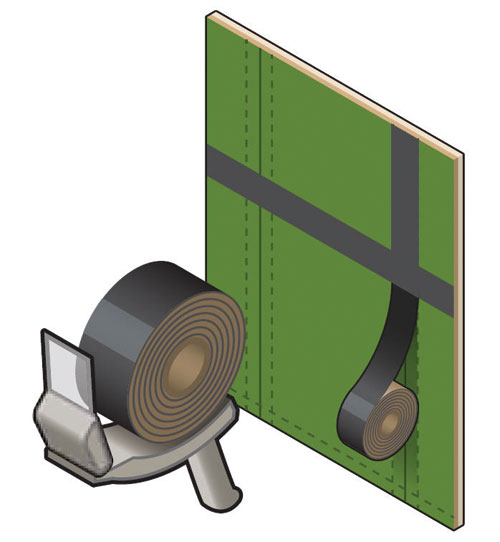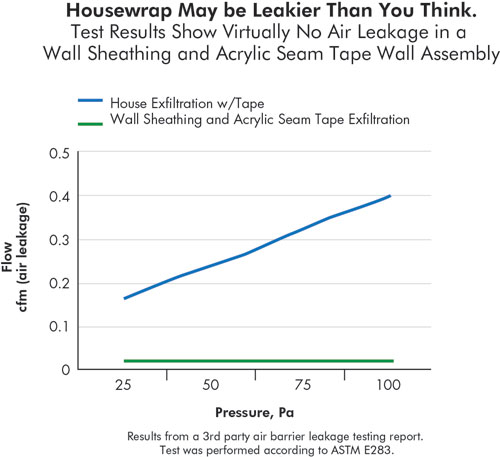Acrylic Flashing Tape Keeps It Together
Air Barrier Materials vs. Those That Do Not Qualify
With air barrier references appearing more frequently in codes and energy rating systems, it is important to know what goes into the creation of an effective air barrier system. According to the Whole Building Design Guide, a program of the National Institute of Building Sciences, builders and architects should carefully consider materials that will form part of such a system.
Loose-laid air barriers like housewraps can only protect against infiltration and that is only with special detailing. In order to function as an air barrier, wraps must be sealed to the wall at the bottom of a wall. The tighter you make wraps, the higher the risk of water getting trapped between the wrap and the wood sheathing, which can cause moisture-related problems with your wall system. According to experts in the field,2 materials that do not qualify as air barrier materials without additional coatings are:
- Uncoated concrete block
- Plain and asphalt impregnated fiberboard
- Expanded polystyrene
- Batt and semi-rigid fibrous insulation
- Perforated house-wraps
- Asphalt impregnated felt, 15 or 30 lb.
- Tongue and groove planks
- Vermiculite insulation
- Cellulose spray-on insulation
In adopting the simplest method of air tightening a wall, the Whole Building Design Guide recommends selecting “one of the layers such as the sheathing and to air tighten it using durable tapes, adhesive sheet products, fluid-applied materials, or the like.” However, when it comes to liquid-applied barriers, either spray on or roll-on, there are several disadvantages. The labor-intensive application process can be expensive. Cure times differ depending on the product and conditions in the immediate environment, with restrictions during certain wind and temperature conditions. In urban areas and occupied buildings, overspray can pose a significant issue. In comparison, taped wall sheathing is not as weather dependent and is much easier to install and inspect.
ACRYLIC TAPES HELP ACHIEVE AIRTIGHT BARRIERS |
Self adhesive tapes have made significant contributions in providing a rigid and continuous air barrier assembly to significantly reduce air leakage, contributing to comfort and energy efficiency. Through simple installation of panels and tape, seams and penetrations can be sealed, cutting off leak paths that compromise performance and energy efficiency. Such a high-performance assembly is code recognized as an air barrier assembly and has demonstrated performance benefits over housewrap systems. ASTM E2357 – Standard Test Method for Determining Air Leakage of Air Barrier Assemblies The ASTM E2357 Standard was developed to provide a uniform method to evaluate a full air barrier assembly. Until this method was developed, one could only evaluate pieces of the air barrier assembly such as the air barrier material alone or the flashing material alone. This method also incorporates wind loads that will push and pull on the assembly, exposing weak areas that could leak air. In this test, a full air barrier assembly of a high-performance wall assembly secured by acrylic tape was installed as an 8-foot by 8-foot mock-up of a realistic exterior wall including penetrations for pipes, electrical outlets and a window opening. All noted penetrations were flashed with acrylic tape. The system was then subjected to positive and negative sustained wind and wind gust loading simulating real life conditions. Air leakage measurements for the wall assembly were well below (less than 1/5th) the maximum allowable level. |
 |
Acrylic tape easily fastens panel seams. Illustration courtesy of Huber Engineered Woods |
Comparison Testing - Air Movement in High-Performance Wall Assemblies and Housewrap Assemblies
In third-party air leakage testing, a wall assembly constructed with high-performance wall sheathing and acrylic tape was compared to an assembly with traditional OSB sheathing and a common housewrap with tape. Both assemblies were identically constructed for a system-to-system performance comparison. In this lab test, the high-performance wall sheathing assembly allowed significantly less air flow/leakage than the housewrap and tape system. Results indicate that a high-performance wall assembly secured with acrylic tape contributes to a tighter building envelope. These assemblies of wall panels and tape seal panel seams and allow less air leakage, resulting in greater comfort and lower energy bills for the homeowner.
 |
|
Acrylic tape outperforms housewrap in third-party testing. Illustration courtesy of Huber Engineered Woods |









